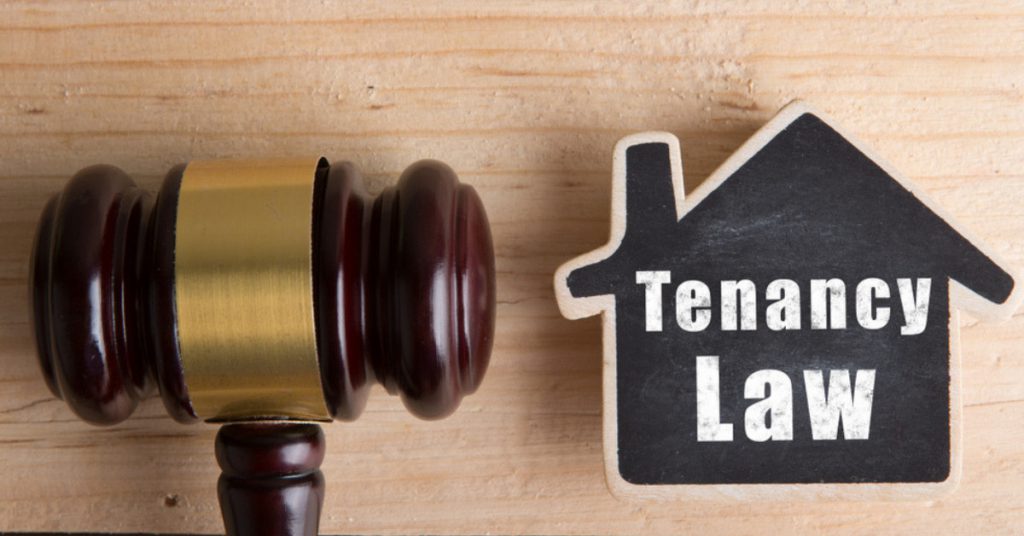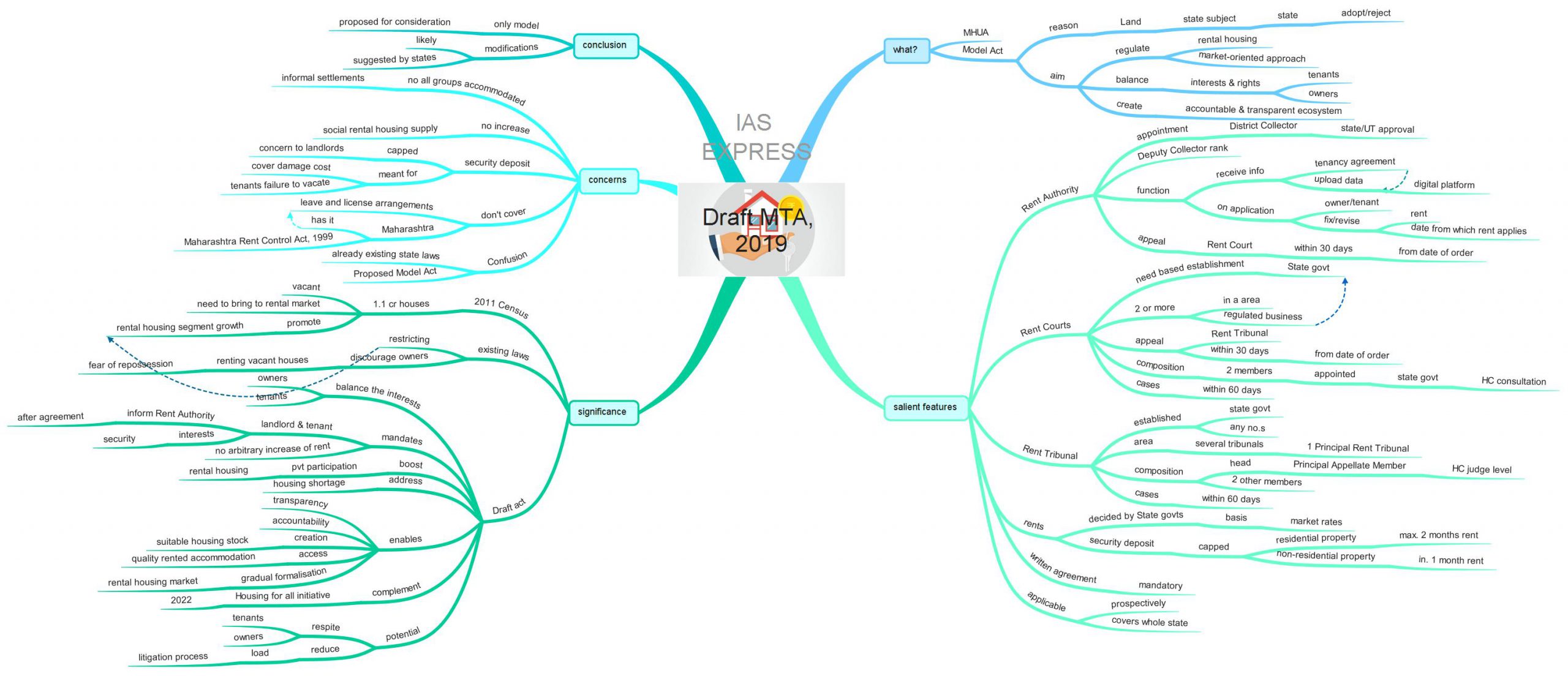Draft Model Tenancy Act 2019: Features, Significance, Concerns

From Current Affairs Notes for UPSC » Editorials & In-depths » This topic
IAS EXPRESS Vs UPSC Prelims 2024: 85+ questions reflected
India’s real estate environment has been facing land market distortions, including inflexible zoning, rent control and protected tenancies for many years now. These were harmful to the health of this market. The earlier Rent Control Act was an attempt by the government to eliminate the exploitation of tenants by the landlords. However, in the long run, these archaic laws have gathered operational inefficiencies and have led to several adverse situations like weakening investments in rental housing, deteriorating municipal property tax revenue, etc. Due to the acute house shortage and the aspiration to achieve the vision of “Housing for All” by 2022, there is a definite need to incentivize and boost rental housing. These archaic laws do not address the relationship between the lessor and the lessee realistically and fairly. The Model Tenancy Act, 2019, issued by the Centre, seeks to address the distortions in India’s rental markets and could help streamline it.
What is the Draft Model Tenancy Act 2019?
- This year, the Ministry of Housing and Urban Affairs (MHUA) released the Draft Model Tenancy Act, 2019.
- This Act’s objective to regulate rental housing by a market-oriented approach.
- It is a “model Act” because the land is a state subject and the states have the option to either adopt or reject it.
- The Model Act aims to create a balance between the interests and the rights of the landlords and the tenants.
- It also intends to create an accountable and transparent ecosystem for renting properties in a disciplined and rule-based fashion.
What are the salient features of this Draft MTA, 2019?
- Rental Authority:
- The District Collector, with prior approval of the State/ UT government, can appoint the Rent Authority (at the rank of Deputy Collector).
- The Rent Authority, after receiving the information on the tenancy agreement, must upload data related to the agreement on its website.
- For this purpose, a digital platform will be set up in the local vernacular language of the state.
- The Rent Authority may also, on application by the landowner or tenant, fix or revise the rent and the date from which the rent would apply.
- Appeals against the Authority’s order come under the jurisdiction of the Rent Court and must be made within 30 days from the date of the order.
- Rent Courts:
- As per the Draft MTA, a State government may establish as many Rent Courts as it needs.
- Two or more courts can be set up for any area. In such cases, the State/UT government can regulate the distribution of the business among them.
- Appeals against a Rent Court’s orders will lie with the Rent Tribunal. This must be made within 30 days from the date of the order.
- Composition: It may consist of two members who are appointed by the State/UT government in consultation with the High Court.
- Rent Tribunal:
- The State government may set up as many Rent Tribunals it deems necessary.
- If a particular area has several of such Tribunals, the State/ UT governments may notify one of them as the Principal Rent Tribunal.
- Composition: The Tribunal will be headed by a Principal Appellate Member (at the level of an HC judge). It will also consist of two other members.
- The Rent Courts and Tribunals will seek to dispose of the cases within 60 days.
- Rents:
- Landlords will be able to charge rents that are decided by the respective State governments and these decisions are based on the market rates.
- This Draft also proposed to cap the security deposit equal to a maximum of 2 months’ rent in case of residential properties and, a minimum of 1 month’s rent in case of non-residential property.
- Mandatory Agreement: After this Act comes to force, no individual shall let or take on rent of any premises except by an agreement in writing.
- Applicability: The Model Act covers the whole of the state i.e., both the urban and rural areas in the state.
- Also, the Act will be applied prospectively and will not affect the existing tenancy.
What is the significance of Draft MTA?
- As per the Census 2011, about 1.1 crores of houses are vacant.
- This Act may bring these into the rental market and would promote the growth of the rental housing segment.
- According to the MHUA, the existing rent control laws are restricting the growth of rental housing and discourage owners from renting out their vacant houses due to the fear of repossession.
- The MHUA pointed out that one of the potential measures to unlock the vacant house is to bring in transparency and accountability in the existing system of renting premises and to balance the interests of both the property owners and the tenant in a judicious manner. The Draft Act does the same.
- As per the Act, it will be mandatory for both the landlord and the tenant to inform the Rent Authority after getting into an agreement.
- This will ensure that a landlord does not arbitrarily increase the rent in variance with what had been agreed to in the agreement.
- It will also ensure that the tenant is not evicted at the whim of the landlord.
- The Draft MTA is expected to boost private participation in rental housing and can address the housing shortage in India.
- It will also enable the creation of suitable housing stock for various income segments in society.
- It can increase access to quality rented accommodation.
- This Act, if implemented in states, may enable gradual formalisation of the rental housing market.
- Making these vacant houses available in the market can complement the vision of “Housing for all” by 2022.
- Draft MTA has the potential to provide respite to both the tenants and the landowners and can bring down some of the loads of the already overloaded litigation process.
What are the concerns?
- The proposed Model Act takes into account the current market conditions in relation to the renting and leasing of the premises and is setting out the rights and obligations of the landowner, tenant, and even project manager if one is appointed.
- Setting up of redressal mechanisms for speedy disposal of disputes is also creditable.
- The Model Act, if adopted and enforced in the States and UTs, will ensure better regulation of the private rental housing market for the middle and higher-income segments.
- What it is not likely to do, however, is ensure robust rental housing stock that accommodates all groups, including a large number of people in cities who are forced to live in informal settlements; nor is it likely to increase the social rental housing supply.
- One concern that may arise from the landlords proposing to lease their residential premises is the cap on the amount of security deposit that may be taken under the agreement with the tenant.
- Usually, the security deposit is meant to cover the cost of any damages caused to the premises by the tenant as well as failure by the tenant to vacate the premises.
- Capping of this may not be viewed positively by the landlords.
- Also, the Proposed Model Act only covers tenancy and lease of the premises and is silent on the leave and license arrangements.
- This may be an issue that may be left to the states. For example, Maharashtra has provided for the concept of leave and license and the obligation of the landlord to register such agreement comes under the Maharashtra Rent Control Act, 1999.
- Further, one also needs to consider the confusion that may be caused by the implementation of the Proposed Model Act in the states where specific rent control Acts already exists.
- For example, Maharashtra has a well-established rent control Act, which has certain provisions like an exception for companies that have paid-up capital more than 1 crore as well as other groups of entities who are exempted from the provisions of the rent control Act.
Conclusion:
As the Model Act is currently only a model that is proposed for consideration, one will have to wait for further modifications, if any, which states may suggest and also, the rules which each state may frame.
If you like this post, please share your feedback in the comments section below so that we will upload more posts like this.


